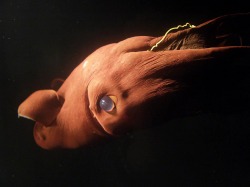 Vampyroteuthis Infernalis Vampyroteuthis Infernalis Deep down in the depths of the abyss, there is a creature, living in the dark, that seems to come straight from our nightmares... It's Vampyroteuthis Infernalis - the Vampire Squid from Hell! It lives in what is known as the Oxygen Minimum Zone, about 600 - 1100m below sea level, and it is the only know member of its order: Vampyromorphidia. They can be anything from black to red in colour, which is in part what gives them their name, and their eyes, which, depending on the light, can be red or a translucent blue, are huge compared to the rest of their body, which reaches a maximum of about 15cm long, and about 30cm with its limbs extended. Originally classified as an Octopus by German teuthologist Carl Chun, it is now believed that the Vampire Squid sits between the classifications of Squid and Octopus. It has eight limbs, but also has the filaments of a squid, which retract into the part of the gelatinous web, between their first and second limbs. It is thought, however, that the filaments are more like the ones lost by the ancient Octopus than those of the modern Squid. Its most interesting feature, however, is its bio-luminescence which it uses for self-defence. One way ol' Vampy does this is by something called counter-luminescence, which means that, when in the shallower part of its habitat, around 600m down, it counters the fact that its silhouette can be seen by predators from below by emmiting light from its own body, effectively cloaking its presence from danger. Another way that it uses this bio-luminescence is in the tips of its limbs. By highlighting areas away from the head and vital organs, if an attack is made, the Vampire can escape with just a mangled limb, which it can regenerate later. It has great control over the photophores on its body, and can cause disorienting flashes or prolonged lighting effects as required. Like most deep water cephalopods, the Vampire has no ink sac, as deep down in the depths, an ink attack would be all but useless. Instead, it can throw out bioluminescent clouds, which can glow for up to 9.5 minutes. These clouds are believed to come from organs on the tips of the limbs. This cloud is only produced in extreme danger, as it takes some time to regenerate the photophores. In the video below, the bit about the Vampire Squid starts at 0:50. Before that, we are treated to a return of one of our favourite animals here at Show Me Something Interesting: The Dumbo Octopus! If you want to read more, here are a few sites to look at: http://tolweb.org/Vampyroteuthis_infernalis/20084 - Great for general information. http://www.biolbull.org/cgi/reprint/205/2/102.pdf - On the production of light in the limb tips. http://jeb.biologists.org/cgi/reprint/201/16/2413.pdf - About the way the Vampire moves. http://www.springerlink.com/content/xj5x22l017552117/fulltext.pdf - About its blood in relation to living in the Oxygen Minimum Zone.
1 Comment
yabey
5/1/2013 07:19:07 pm
i find the creature very interesting. Its unique, beautiful and the last of its species
Reply
Your comment will be posted after it is approved.
Leave a Reply. |
MOST VIEWED POSTS
© James Edward Hughes 2013
 RSS Feed
RSS Feed





